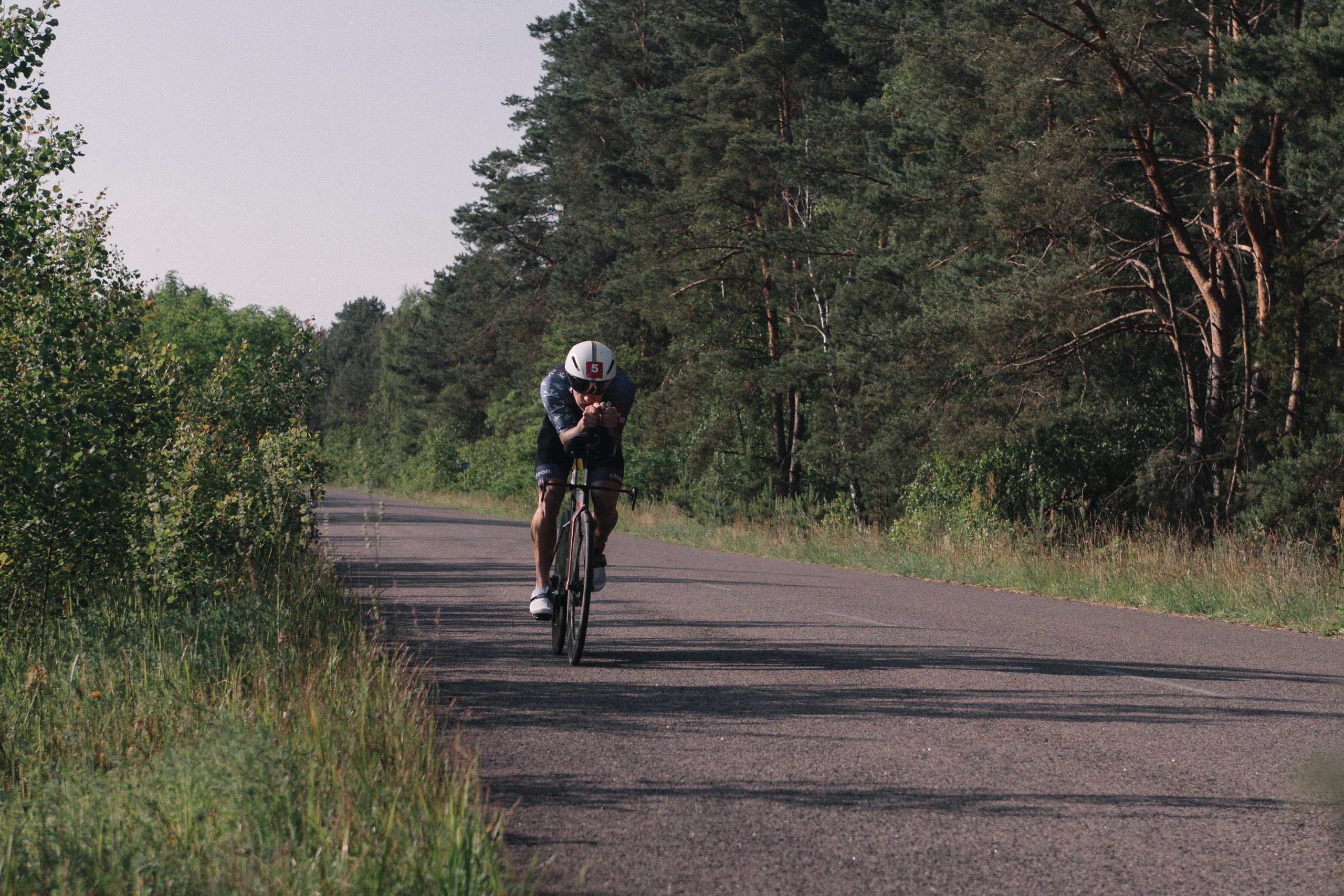You’re halfway through a sunny 10K, feeling strong, when suddenly your energy dips.
The sun feels hotter, your mouth dry, and your legs heavier with each step.
You fumble for the bulky bottle in your hand, annoyed by how it sloshes, or perhaps you didn’t bring water at all, banking on a drinking fountain that never appeared. Sound familiar?
For runners, hydration isn’t just about quenching thirst — it’s about staying ahead of fatigue, avoiding discomfort, and keeping your rhythm intact.
Whether you’re gearing up for a sprint or mapping out your triathlon training plan for a successful race, carrying water the right way can make a world of difference.
The key is to find a method that fits your needs, doesn’t weigh you down, and keeps you hydrated without breaking your stride.
In this guide, we’ll help you navigate the options of how to carry water when running and share some tips so you can focus on what matters most — enjoying the run.
Hydration Needs for Runners
When you run, your body heats up, and you start sweating to cool down.
This is your body doing its job, but it also means you’re losing water and important minerals (called electrolytes) along the way.
Without enough fluids, your energy dips, your muscles don’t work as well, and you might even start to feel dizzy or sluggish.
If you are getting ready for a triathlon and looking for some tips on hydration, make sure you check out our recent blog on optimal hydration training for triathletes.
How Much Water Do You Really Need When Running?
There’s no one-size-fits-all answer because every runner is different.
How much you sweat depends on things like how hard you’re running, the weather, and even your body size.
The American College of Sports Medicine (ACSM) recommends consuming 400–800 ml (13–27 oz) of water per hour during exercise, depending on your sweat rate and environmental conditions.
However, hydration needs vary widely among runners.
But here’s a smarter way to figure it out:
-
The Sweat Test
Weigh yourself before and after a run. For every pound you lose, you’ll want to drink about 16–24 ounces to make up for it. This simple trick helps you understand your personal hydration needs better than any general rule.
-
Watch for Signs
If your mouth feels super dry, or your sweat turns sticky, it’s your body’s way of saying, “Hey, I need water!”
To personalize your hydration strategy, weigh yourself before and after a run to estimate how much fluid you lose. For every pound lost, aim to drink about 16–24 oz (480–720 ml) of water to rehydrate effectively.
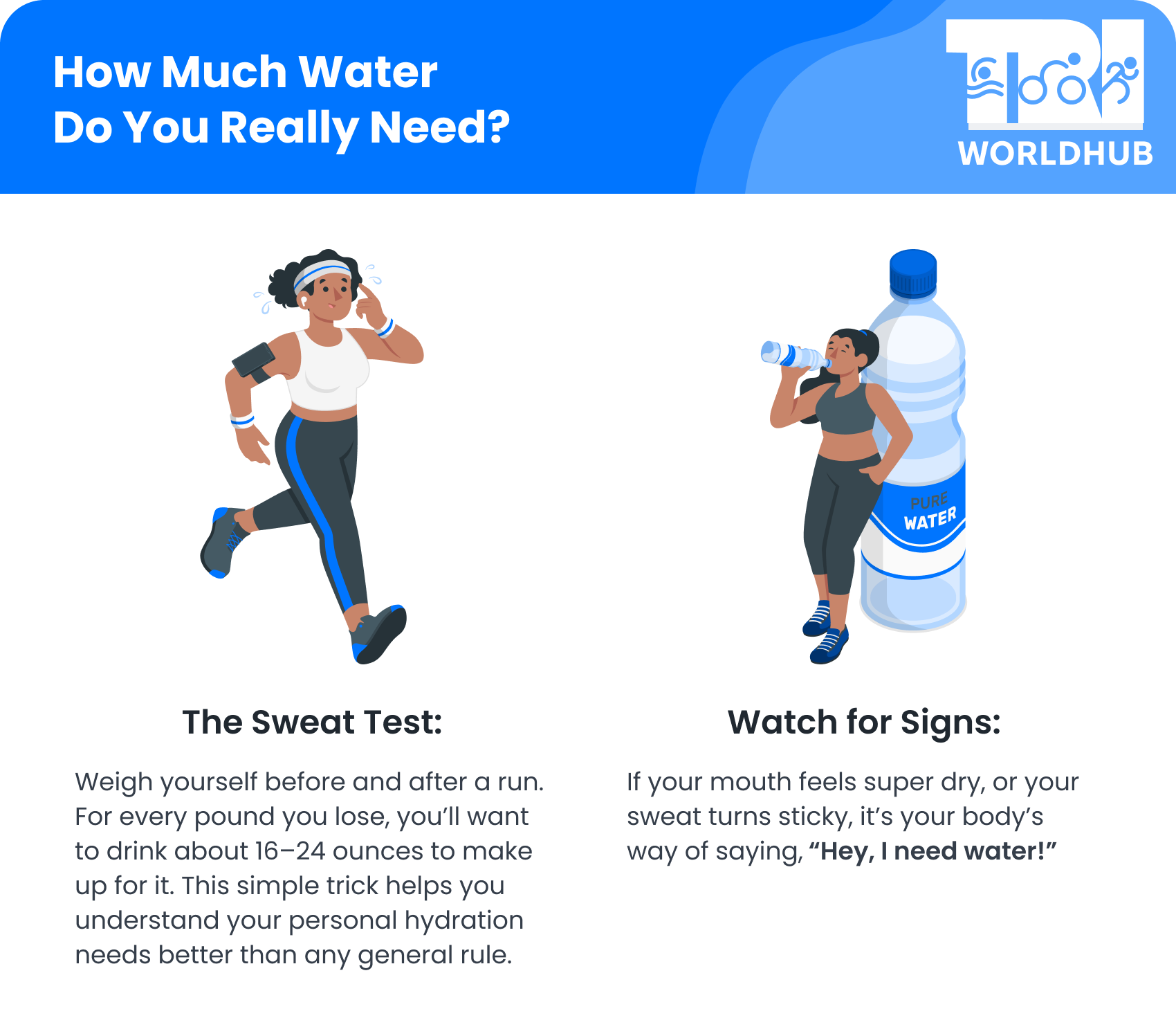
The Risks of Too Much Water
Yes, dehydration is bad — but did you know drinking too much water can also mess you up?
Overhydrating can dilute the sodium in your blood, leading to a condition called hyponatremia.
This can cause bloating, headaches, and, in extreme cases, serious health issues.
The key is balance: drink enough to replace what you’re losing but don’t go overboard.
Don’t Forget Electrolytes
Water alone isn’t always enough, especially if you’re running for more than an hour or it’s hot outside.
Electrolytes — like sodium, potassium, and magnesium — help your body hold onto water and keep your muscles firing on all cylinders. Learn how magnesium can help prevent cramps and improve endurance with insights from our magnesium for athletes article.
A sports drink or electrolyte tablet can be a lifesaver during those longer runs.
Learn more about electrolytes and their role in cramps prevention in our article on how to prevent cramps while running.
Choosing the Right Method to Carry Water
There are a few key factors to consider when you choose the best way to carry water during your run.
These are: how far and long you’re running, the weather, and the terrain.
For shorter runs, a simple handheld water bottle or a lightweight hydration belt usually does the trick.
These are great options if you’re only out for a few miles and want something low-profile.
For longer distances, especially trail runs or hot-weather runs, you’ll likely need more drinking water and possibly some space for snacks, energy gel, or a phone.
That’s where a hydration vest or a backpack comes in — they can hold larger amounts of water while distributing the weight evenly so it doesn’t slow you down.
Comfort is a big deal here.
Some runners love handheld bottles, while others find them distracting.
Hydration belts are a solid middle ground, but they can bounce if not fitted properly.
Try a few options to see what feels right for you, and remember: your hydration strategy should fit both your physical needs and a personal preference.
The goal is to stay fueled and comfortable without overloading yourself.
Now, let’s explore each option in more detail so that you can make an informed decision.
Handheld Bottles
A handheld bottle is one of the simplest and most affordable ways to carry water on shorter runs.
These small bottles are easy to carry and often come with an ergonomic design for a secure grip.
Look for a water bottle with a reliable valve to prevent leaks and a comfortable strap to keep your hand relaxed while running.
Some water bottles even feature small compartments for storing essentials like keys or gels.
For example, a 12 oz soft-grip water bottle with a thumbhole strap is perfect for a 5K run on a warm day.
Pros: Lightweight, affordable, and easy to use.
Cons: Can feel awkward for some runners.
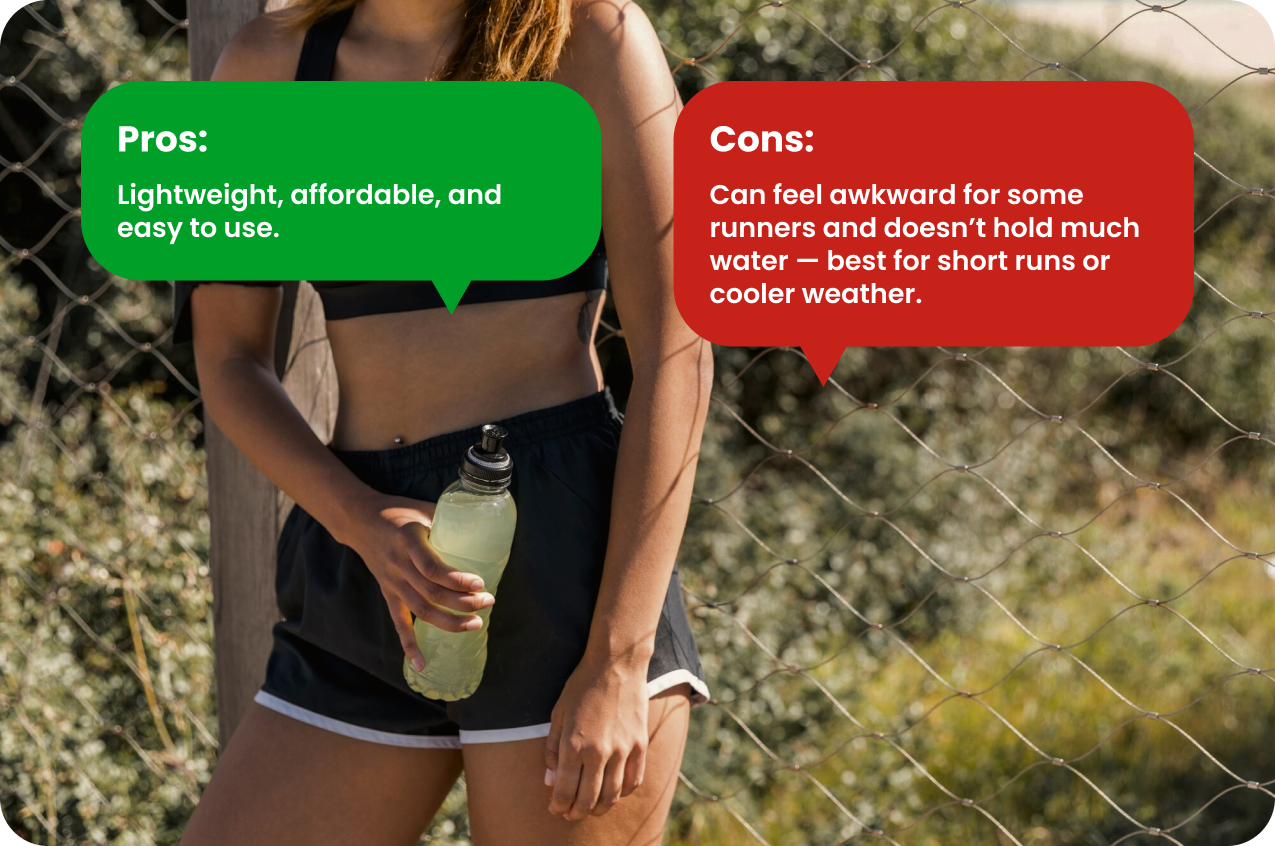
Soft Flasks
Soft flasks are lightweight, flexible bottles that get smaller as you drink. This makes them easy to carry and reduces sloshing.
They’re great for mid-length runs or for storing in a hydration vest, belt, or even a jacket pocket.
Look for one with a bite valve for easy sipping and no leaks. A 500 ml (17 oz) soft flask is a popular choice for its convenience.
Pros: Compact, easy to carry, and simple to store once empty.
Cons: Hard to hold without a strap for long runs and needs regular cleaning to avoid smells.
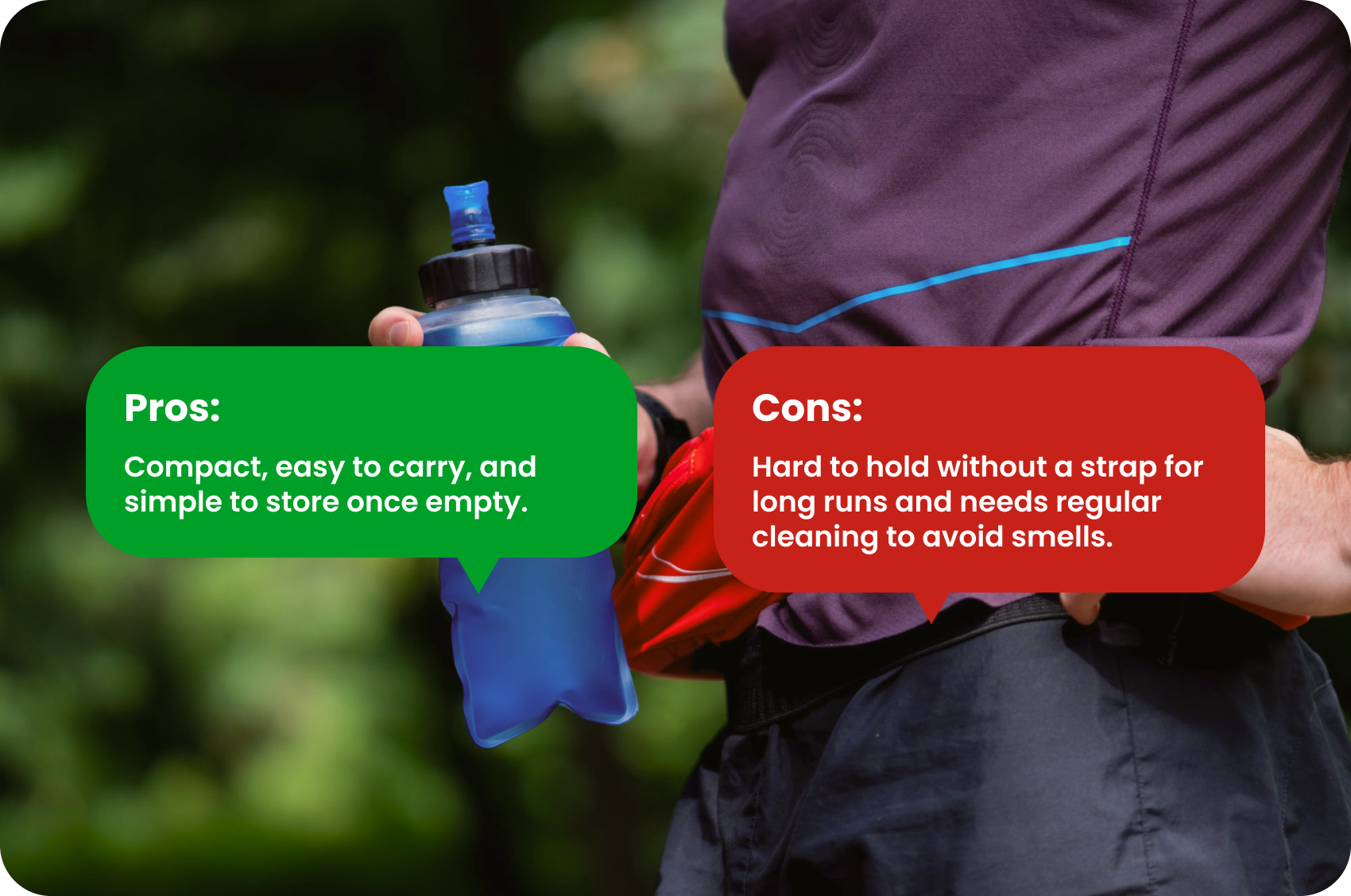
Hydration Belts for Carrying Water
Hydration belts are a great choice for runners who need more water than a handheld water bottle can provide but don’t want the bulk of a vest.
These belts typically come with holsters for multiple smaller bottles or one larger bottle that sits around your waist.
Look for an adjustable belt with a snug fit to minimize bouncing, and consider one with storage compartments for gels, keys, or a phone.
For example, a belt with two 10 oz bottles is ideal for a 10K road race.
Pros: Allows for hands-free running and carries more water and essentials than handheld bottles.
Cons: Can feel uncomfortable or bouncy if not adjusted properly, especially on longer runs.
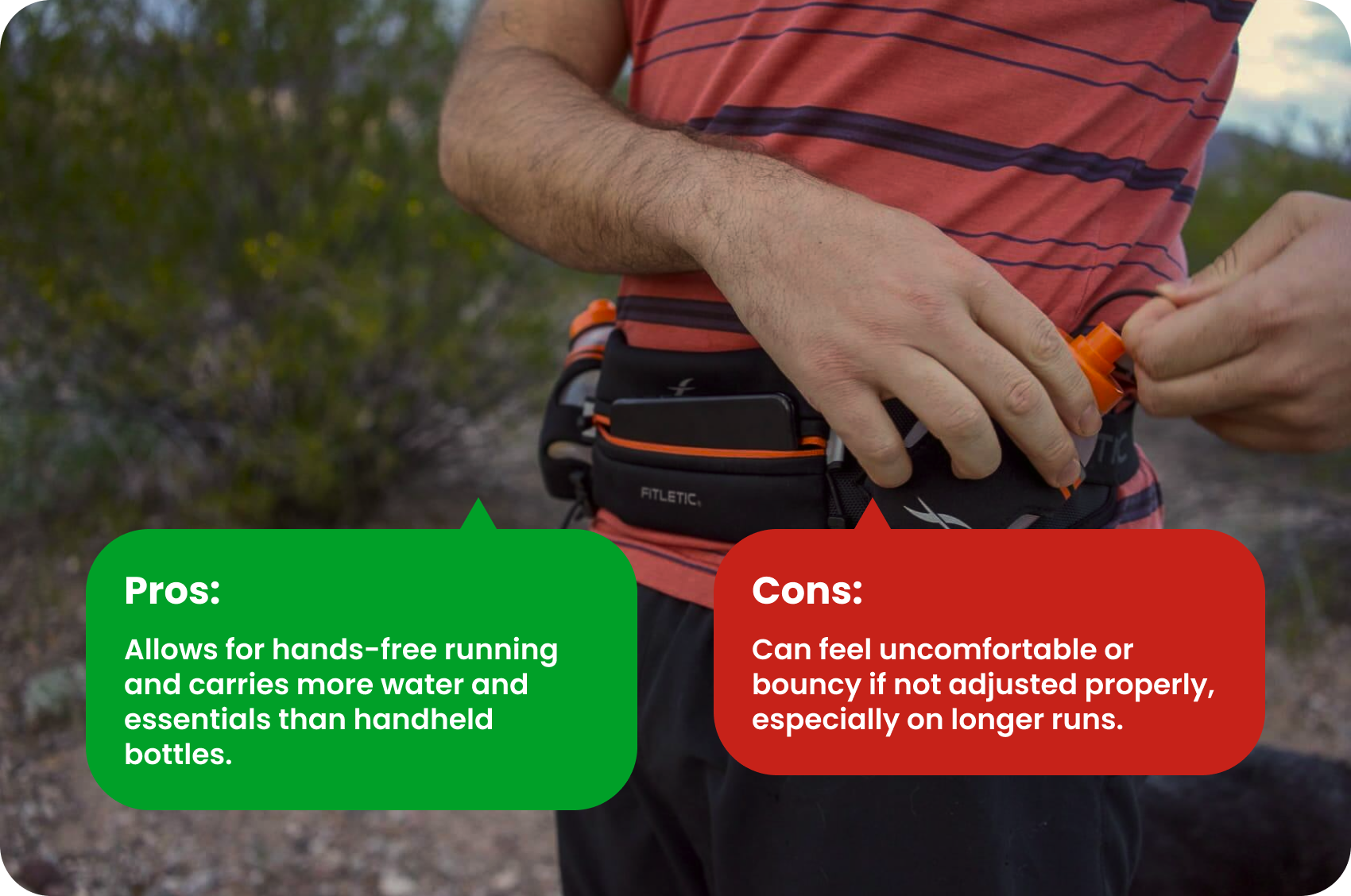
Running Hydration Vests and Backpacks
Hydration vests and backpacks are the go-to running gear for long runs, trail running, or hot-weather training.
Hydration packs are designed to carry larger amounts of water in hydration bladders or bottles while evenly distributing the weight across your upper body.
Many models also have ample storage for energy bars, gels, a phone, or even an extra layer.
A 2L hydration vest is a perfect choice to carry water on your marathon training or an all-day trail run.
Pros: Excellent for carrying large amounts of water and gear, with minimal discomfort when fitted correctly.
Cons: More expensive and bulkier than other options, and they can feel warm in hot weather if not well-ventilated.
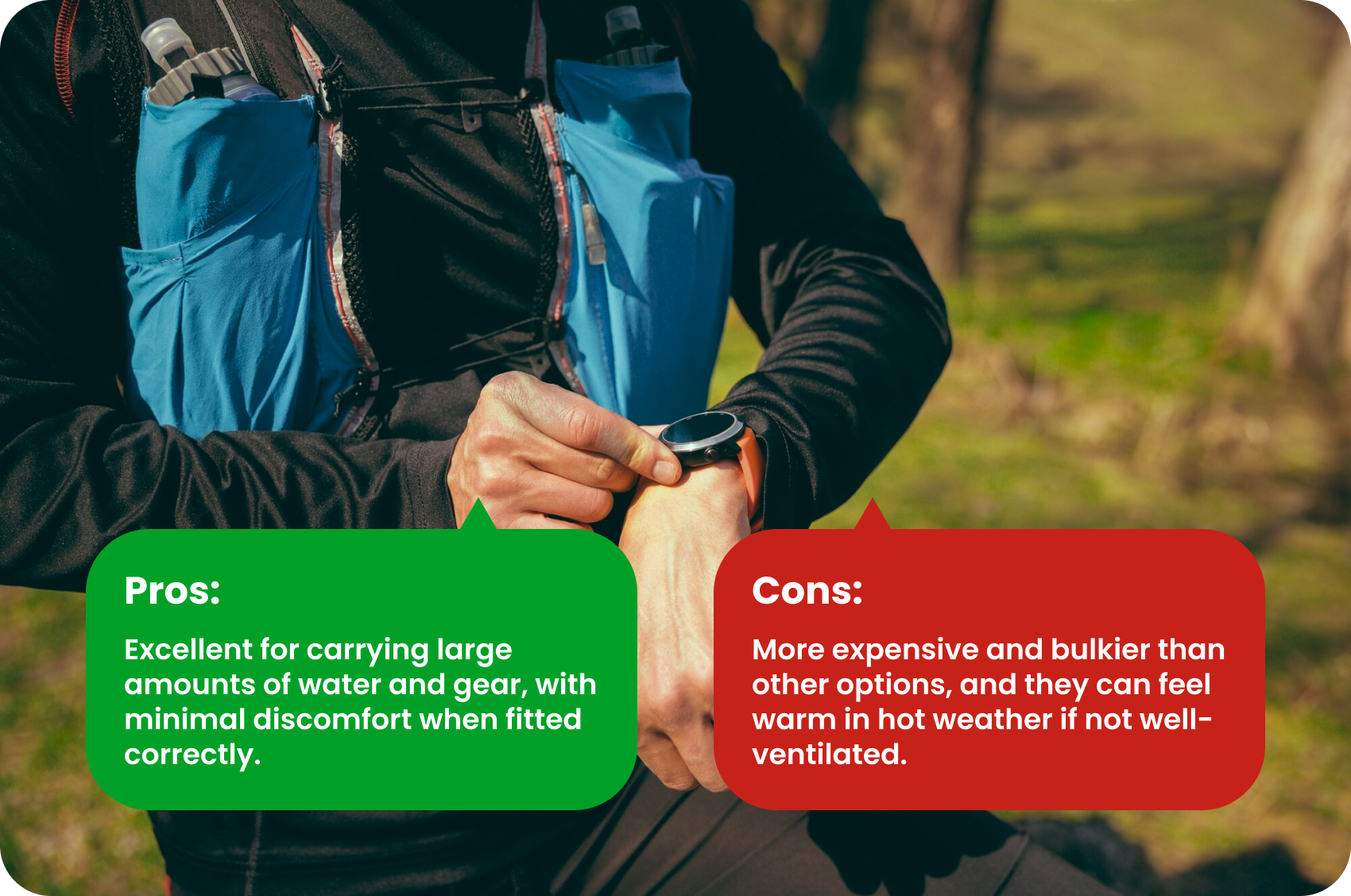
Tips for Comfortable Water Carrying
Carrying water on a run should feel easy and natural.
Start by picking a method that fits your running style and feels good to use.
If you’re going with a hydration belt or vest, make sure it’s snug enough to stay in place but not so tight that it feels restrictive.
Adjust the straps before you head out to avoid any bouncing or shifting.
To keep things comfortable, especially on longer runs, try placing a thin towel or cloth between your skin and the belt or vest to prevent chafing.
If you’re using a handheld bottle, choose one with a comfortable strap so you’re not gripping too hard the entire time.
Practice makes perfect here — use your water carrying gear during training runs to get used to how it feels.
Start with shorter distances and gradually increase to longer ones as you adjust.
This way, you’ll be confident and distraction-free come race day.
Remember, the right setup should support your run, not get in the way!
Common Mistakes to Avoid
Staying hydrated during a run is crucial, but it’s just as important to do it the right way. Small mistakes, like carrying too much water or using uncomfortable gear, can make your run harder than it needs to be.
Carrying too much water
Overloading yourself can make your run feel harder than it should. Choose the right amount based on your distance and needs — more isn’t always better.
Not keeping water cool in hot weather
Warm water isn’t refreshing or effective at cooling you down. Use an insulated bottle or hydration bladder to keep your water at a drinkable temperature during hot runs.
If you’re running a route with drinking fountains, plan your hydration around these stops to avoid carrying excess water.
Skipping regular sips
Don’t wait until you’re thirsty to drink. Dehydration can sneak up quickly, so aim to take small, consistent sips throughout your run.
Using uncomfortable gear
Avoid any setup that chafes or feels awkward. Make sure your water carrying method is secure, comfortable, and suited to your running style.
Check out this base running training plan to level up your endurance and performance.
Conclusion
Keeping hydrated is a key part of any successful run, but it’s just as important to find a method to carry water that works for you.
Whether it’s a handheld water bottle for short jogs or a hydration vest for longer distances, the right setup can make your runs more comfortable and enjoyable.
Remember, hydration isn’t just about carrying water — it’s about drinking it regularly, staying cool, and keeping your gear hassle-free.
Take time to experiment with different options during your training runs to see what fits your style and needs best.
Pay attention to your body and adjust as needed, especially for varying weather or terrain. With a little preparation, you’ll not only run farther and faster but also enjoy the journey a whole lot more.
Stay hydrated, stay strong, and happy running!





